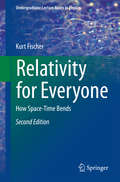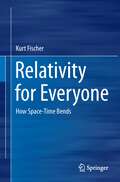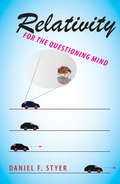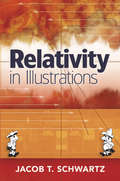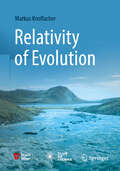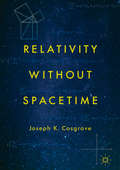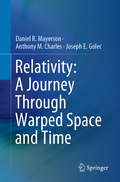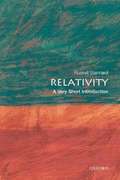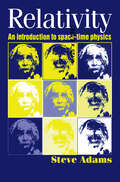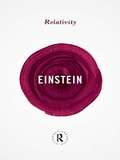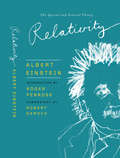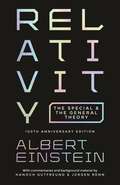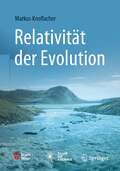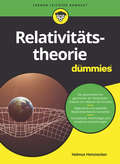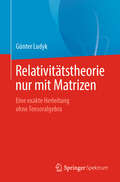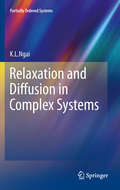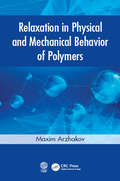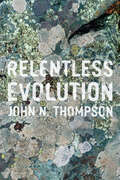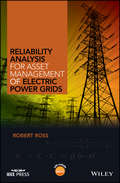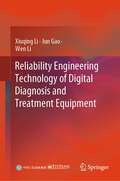- Table View
- List View
Relativity for Everyone
by Kurt FischerThis book, now in a revised and updated second edition, explains the theory of special and general relativity in detail without approaching Einstein's life or the historical background. The text is formulated in such a way that the reader will be able to understand the essence intuitively, and new sections have been added on time machines, the twin paradoxes, and tensors. The first part of the book focuses on the essentials of special relativity. It explains the famous equivalence between mass and energy and tells why Einstein was able to use the theory of electrodynamics as a template for his "electrodynamics of moving bodies". General relativity is then addressed, mainly with the help of thought experiments. Reference is made to the previously introduced special relativity and the equivalence principle and, using many figures, it is explained how space-time is bending under gravity. The climax of the book is the Einstein equation of gravity, which describes the way in which matter bends space-time. The reader is shown how to obtain the famous Schwarzschild solution. Moreover, the book presents a numerically correct and yet intuitive explanation of the classic effects such as light bending and the advance of the perihelion. The book concludes by explaining the Friedmann model of the big bang and why the theory of gravity does not fit with quantum theory.
Relativity for Everyone: How Space-Time Bends
by Kurt FischerThis book explains the theory of special and general relativity in detail, without digressions such as information on Einstein's life or the historical background. However, complicated calculations are replaced with figures and thought experiments, the text being formulated in such a way that the reader will be able to understand the gist intuitively. The first part of the book focuses on the essentials of special relativity. Explanations are provided of the famous equivalence between mass and energy and of why Einstein was able to use the theory of electrodynamics as a template for his "electrodynamics of moving bodies", simply because besides the speed of light, the electric charge itself is also absolute, leading to the relativity of other physical quantities. General relativity is then introduced, mainly with the help of thought experiments. Reference is made to the previously introduced special relativity and the equivalence principle and, using many figures, it is explained how space-time is bending under gravity. The climax of the book comes with the Einstein equations of gravity that describe the way in which matter bends space-time. The reader is shown how to obtain the famous Schwarzschild solution. There follows a numerically correct and yet intuitive explanation of the classic effects such as light bending or the movement of the perihelion. The book concludes by explaining the Friedmann model of the big bang and why the theory of gravity does not fit with quantum theory.
Relativity for Scientists and Engineers (Dover Books on Physics)
by Ray SkinnerAn ideal choice for undergraduate students of science and engineering, this book presents a thorough exploration of the basic concepts of relativity. The treatment provides more than the typical coverage of introductory texts, and it offers maximum flexibility since many sections may be used independently, in altered order, or omitted altogether. Numerous problems -- most with hints and answers -- make this volume ideal for supplementary reading and self-study.Nearly 300 diagrams illuminate the three-part treatment, which examines special relativity in terms of kinematics and introductory dynamics as well as general relativity. Specific topics include the speed of light, the relative character of simultaneity, the Lorentz transformation, the conservation of momentum and energy, nuclei and fundamental particles, the principle of equivalence and curved space-time, Einstein's equations, and many other topics.
Relativity for the Questioning Mind
by Daniel F. StyerTo those of us who are not mathematicians or physicists, Einstein’s theory of relativity often seems incomprehensible, exotic, and of little real-world use. None of this is true. Daniel F. Styer’s introduction to the topic not only shows us why these beliefs are mistaken but also shines a bright light on the subject so that any curious-minded person with an understanding of algebra and geometry can both grasp and apply the theory.Styer starts off slowly and proceeds carefully, explaining the concepts undergirding relativity in language comprehensible to nonscientists yet precise and accurate enough to satisfy the most demanding professional. He demonstrates how the theory applies to various real-life situations with easy equations and simple, clear diagrams. Styer's classroom-tested method of conveying the core ideas of relativity—the relationship among and between time, space, and motion and the behavior of light—encourages questions and shows the way to finding the answers. Each of the book’s four parts builds on the sections that come before, leading the reader by turn through an overview of foundational ideas such as frames of reference, revelatory examples of time dilation and its attendant principles, an example-based exploration of relativity, and explanations of how and why gravity and spacetime are linked. By demonstrating relativity with practical applications, Styer teaches us to truly understand and appreciate its importance, beauty, and usefulness.Featuring worked and end-of-chapter problems and illustrated, nontechnical explanations of core concepts, while dotted throughout with questions and answers, puzzles, and paradoxes, Relativity for the Questioning Mind is an enjoyable-to-read, complete, concise introduction to one of the most important scientific theories yet discovered. The appendixes provide helpful hints, basic answers to the sample problems, and materials to stimulate further exploration.
Relativity in Illustrations
by Jacob T. SchwartzFirst formulated in the early years of the 20th century, Einstein's theories of relativity overturned long-held concepts of space and time. They provided a radically new way of looking at the physical world and explanations for many questions unanswered by classical physics. Unfortunately, many laypeople consider relativity so abstruse and complicated that they despair of ever understanding it. In reality, the ideas, although profound, are quite simple.That simplicity is strikingly illuminated in this delightfully nontechnical book, which explains relativity in a straightforward, carefully illustrated manner the intelligent layperson can understand. A little high-school geometry will enable the reader to follow the discussion. Moreover, the book includes more than 60 drawings to illustrate concepts more clearly than verbal explanations could ever do.Beginning with the questions "What is Time?" and "What is Space?" the author gradually introduces concepts from ordinary geometry needed to follow the development of Einstein's ideas. Having grasped this foundation, the reader is prepared to understand the specific nature and ramifications of relativity theory. To further increase comprehension, the book is planned so that the text and illustrations face each other on a two-page spread, making it easy for the reader to refer from the text to the illustrations.Clear, engrossing and well-balanced, this remarkably accessible treatment offers an ideal introduction to one of the most important physical theories of the 20th century. It can be read with profit by high-school and college students, teachers, scientists, or any reader fascinated by Einstein's epoch-making theories and their far-reaching implications.
Relativity of Evolution
by Markus KnoflacherThis book focuses primarily on evolutionary processes (rather than evolutionary history). Topics covered are abiotic framework conditions, morphology and physiology of living organisms, fossil and molecular evidence of evolutionary developments. The basic processes of biological evolution are already established in unicellular organisms. Evolutionary options for multicellular organisms arise in a simplified way from the usable energetic transformation potentials and the dynamics of abiotic and biotic interactions. Evolutionary processes of multicellular organisms are therefore predominantly determined by the conditions of the surrounding systems. This is most clearly shown by comparisons of the evolutionary development of vertebrates under marine and terrestrial conditions. For reasons of efficiency alone, no single species can have the equipment to capture and sustainably shape the surrounding systems in the long term. Depending on the available energetic transformation potentials, a single species is very well able to change the surrounding systems - but without being able to capture the resulting long-term consequences. This gives rise to fundamentally new questions for the design and limits of social action that makes sense in the long term. This book is a translation of an updated and revised version of the original German work: Relativität der Evolution, ISBN 978-3-662-63936-8. Translated by Robert D. Martin.
Relativity without Spacetime
by Joseph K. CosgroveIn 1908, three years after Einstein first published his special theory of relativity, the mathematician Hermann Minkowski introduced his four-dimensional “spacetime” interpretation of the theory. Einstein initially dismissed Minkowski’s theory, remarking that “since the mathematicians have invaded the theory of relativity I do not understand it myself anymore.” Yet Minkowski’s theory soon found wide acceptance among physicists, including eventually Einstein himself, whose conversion to Minkowski’s way of thinking was engendered by the realization that he could profitably employ it for the formulation of his new theory of gravity. The validity of Minkowski’s mathematical “merging” of space and time has rarely been questioned by either physicists or philosophers since Einstein incorporated it into his theory of gravity. Physicists often employ Minkowski spacetime with little regard to the whether it provides a true account of the physical world as opposed to a useful mathematical tool in the theory of relativity. Philosophers sometimes treat the philosophy of space and time as if it were a mere appendix to Minkowski’s theory. In this critical study, Joseph Cosgrove subjects the concept of spacetime to a comprehensive examination and concludes that Einstein’s initial assessment of Minkowksi was essentially correct.
Relativity: A Journey Through Warped Space and Time (Springerbriefs In Physics Ser.)
by Daniel R. Mayerson Anthony M. Charles Joseph E. GolecThis primer brilliantly exposes concepts related to special and general relativity for the absolute beginner. It can be used either as an introduction to the subject at a high school level or as a useful compass for undergraduates who want to move the first steps towards Einstein's theories.The book is enhanced throughout with many useful exercises and beautiful illustrations to aid understanding.The topics covered include: Lorentz transformations, length contraction and time dilation, the twin paradox (and other paradoxes), Minkowski spacetime, the Einstein equivalence principle, curvature of space and spacetime, geodesics, parallel transport, Einstein’s equations of general relativity, black holes, wormholes, cosmology, gravitational waves, time machines, and much more.
Relativity: A Very Short Introduction
by Russell StannardIf you move at high speed, time slows down, space squashes up and you get heavier. Travel fast enough and you could weigh as much as a jumbo jet, be flattened thinner than a CD without feeling a thing--and live forever! As for the angles of a triangle, they do not always have to add up to 180 degrees. And then, of course, there are black holes. These are but a few of the extraordinary consequences of Einstein's theory of relativity. It is now over a hundred years since he made these discoveries, and yet the general public is still largely unaware of them. Filled with illuminating anecdotes and fascinating accounts of experiments, this book aims to introduce the interested lay person to the subject of relativity in a way which is accessible and engaging and at the same time scientifically rigorous. With relatively few mathematical equations--nothing more complicated than the Pythagoras's Theorem--this VSI packs a lot time into very little space, and for anyone who has felt intimidated by Einstein's groundbreaking theory, it offers the perfect place to start.
Relativity: An Introduction to Spacetime Physics
by Steve AdamsProvides the essential principles and results of special relativity as required by undergraduates. The text uses a geometric interpretation of space-time so that a general theory is seen as a natural extension of the special theory. Although most results are derived from first principles, complex and distracting mathematics is avoided and all mathe
Relativity: The Special And General Theory (Routledge Great Minds)
by Albert EinsteinTime magazine's "Man of the Century", Albert Einstein is the founder of modern physics and his theory of relativity is the most important scientific idea of the modern era. In this short book, Einstein explains, using the minimum of mathematical terms, the basic ideas and principles of the theory that has shaped the world we live in today. Unsurpassed by any subsequent books on relativity, this remains the most popular and useful exposition of Einstein's immense contribution to human knowledge. With a new foreword by Derek Raine.
Relativity: The Special and the General Theory
by Roger Penrose Albert EinsteinRobert Geroch builds on Einstein's work with commentary that addresses the ideas at the heart of the theory, bringing a modern understanding of relativity to the text. He elucidates how special relativity is a reconciliation of the contradictions between the nature of light and the principle of relativity; he expands on Einstein's treatment of the geometry of space-time and the fundamental notion of an "event"; he explains in detail, but without technical language, the equivalence of inertial and gravitational mass, a cornerstone of general relativity.
Relativity: The Special and the General Theory - 100th Anniversary Edition (Classic Reprint Ser.)
by Albert EinsteinA handsome annotated edition of Einstein’s celebrated book on relativityAfter completing the final version of his general theory of relativity in November 1915, Albert Einstein wrote Relativity. Intended for a popular audience, the book remains one of the most lucid explanations of the special and general theories ever written. This edition of Einstein’s celebrated book features an authoritative English translation of the text along with commentaries by Hanoch Gutfreund and Jürgen Renn that examine the evolution of Einstein’s thinking and cast his ideas in a modern context. Providing invaluable insight into one of the greatest scientific minds of all time, the book also includes a unique survey of the introductions from past editions, covers from selected early editions, a letter from Walther Rathenau to Einstein discussing the book, and a revealing sample from Einstein’s original handwritten manuscript.
Relativität der Evolution
by Markus KnoflacherDieses Werk fokussiert vor allem auf evolutionäre Prozesse (und weniger auf evolutionäre Geschichte). Themen sind abiotische Rahmenbedingungen, Morphologie und Physiologie lebender Organismen, fossile und molekulare Hinweise auf evolutionäre Entwicklungen. Die grundlegenden Prozesse biologischer Evolution sind bereits in einzelligen Organismen festgelegt. Entwicklungsoptionen für vielzellige Organismen ergeben sich vereinfacht durch die nutzbaren energetischen Umwandlungspotenziale und die Dynamik der abiotischen und biotischen Wechselwirkungen. Evolutionsprozesse vielzelliger Organismen sind deshalb überwiegend durch die Bedingungen der umgebenden Systeme bedingt. Am deutlichsten zeigen dies Vergleiche der evolutionären Entwicklung von Wirbeltieren unter marinen und terrestrischen Bedingungen.Allein aus Effizienzgründen kann keine einzige Art die Ausstattung für die Erfassung und langfristig nachhaltige Gestaltung der umgebenden Systeme besitzen. Abhängig von den verfügbaren energetischen Umwandlungspotenzialen ist eine einzelne Art sehr wohl in der Lage die umgebenden Systeme zu verändern – allerdings ohne die daraus resultierenden langfristigen Folgewirkungen erfassen zu können. Daraus ergeben sich grundsätzlich neue Fragestellungen für die Gestaltung und Grenzen eines langfristig sinnvollen gesellschaftlichen Handelns.
Relativitätstheorie für Dummies (Für Dummies)
by Helmut HetzneckerSie wollten schon immer die bekannte Formel E = mc² verstehen? Oder Sie gucken einfach gerne in den Sternenhimmel und staunen über die unendliche Weite des Universums? Vielleicht möchten Sie auch schlichtweg mehr über Galileo Galilei, Johannes Kepler, Isaac Newton oder Albert Einstein erfahren? Da liegen Sie mit diesem Buch goldrichtig. Angefangen bei den Grundlagen der Relativitätstheorie erklärt Ihnen Dr. Helmut Hetznecker anschaulich, einfach und mit einer großen Portion Witz, was es bedeutet, wenn sich Zeit ausdehnt, sich Raum verkürzt, sich Massen vergrößern oder das Universum expandiert.
Relativitätstheorie nur mit Matrizen: Eine exakte Herleitung ohne Tensoralgebra
by Günter LudykDieses Buch bietet eine Einführung in die spezielle und allgemeine Relativitätstheorie für Physiker, Ingenieure und andere Naturwissenschaftler, die einen Einstieg in das Thema suchen, ohne sich in zu viel neue Mathematik einzuarbeiten.Einsteins grundlegende Gleichungen werden so ohne die Hilfe von Tensoren das erste Mal nur mit Hilfe der Matrizenalgebra hergeleitet. Im 1. Kapitel wird die spezielle und im 2. Kapitel die allgemeine Relativitätstheorie behandelt. Die Schwarzschildlösung für eine kugelförmige Masse wird im 3. Kapitel angegeben, sowie "Schwarze Löcher" vorgestellt und untersucht. Noch erforderliche Mathematik wird entweder direkt oder im Anhang zur Verfügung gestellt.
Relativitätstheorie: Speziell, Allgemein und Kosmologisch
by Sebastian Linden Wolfgang RindlerDieses Buch bringt Studierenden schon in frühen Semestern die spannenden und herausfordernden Aspekte der Relativitätstheorie und der modernen Kosmologie nahe und hält gleichzeitig auch für Fortgeschrittene und Wissenschaftler reichlich neues Material bereit. Die besondere Stärke des Buches ist die Betonung der fundamentalen, logischen und geometrischen Aspekte der Theorie. Berücksichtigt werden sowohl die spezielle als auch die allgemeine Relativitätstheorie in Verbindung mit aktuellen Entwicklungen der Kosmologie. Eine weitere Besonderheit ist der Vorrang von Anschauung und Verständnis vor mathematischem Formalismus: erst nach Festigung des erworbenen Wissens wird dieses in eine mathematische, handhabbare Form überführt. Das Buch enthält zahlreiche Übungsaufgaben und bietet sich als vorlesungsbegleitende Lektüre an.
Relaxation and Diffusion in Complex Systems
by K. L. NgaiThe usefulness of the book to the reader is exposure to many different classes of materials and relaxation phenomena. They are tied together by the universal relaxation and diffusion properties they share, and a consistent explanation of their origin. The readers can apply what they learn to solve their own problems and use it as a stepping-stone to make further advances in theoretical understanding of the origin of the universality.
Relaxation in Physical and Mechanical Behavior of Polymers
by Maxim ArzhakovExplores the nature of relaxation phenomena in polymers on the basis of time-temperature equivalence. Its role in the physical and mechanical behavior of polymers materials and fundamentals of thermoplastics processing are discussed. Four appendixes detail thermo-mechanical methods to study relaxation in polymers, structure of both amorphous and semi-crystalline polymers, and unified approach to describe deformation of polymeric materials.
Relaxation of the Chemical Bond
by Chang Q SunThe aim of this book is to explore the detectable properties of a material to the parameters of bond and non-bond involved and to clarify the interdependence of various properties. This book is composed of four parts; Part I deals with the formation and relaxation dynamics of bond and non-bond during chemisorptions with uncovering of the correlation among the chemical bond, energy band and surface potential barrier (3B) during reactions; Part II is focused on the relaxation of bonds between atoms with fewer neighbors than the ideal in bulk with unraveling of the bond order-length-strength (BOLS) correlation mechanism, which clarifies the nature difference between nanostructures and bulk of the same substance; Part III deals with the relaxation dynamics of bond under heating and compressing with revealing of rules on the temperature-resolved elastic and plastic properties of low-dimensional materials; Part IV is focused on the asymmetric relaxation dynamics of the hydrogen bond (O:H-O) and the anomalous behavior of water and ice under cooling, compressing and clustering. The target audience for this book includes scientists, engineers and practitioners in the area of surface science and nanoscience.
Releasing Systems in Active Food Packaging: Preparation and Applications (Food Bioactive Ingredients)
by Seid Mahdi Jafari Ana Sanches SilvaValuable progress has been made in food packaging over the past two decades, reflecting advancements in process efficiency, improved safety and quality throughout the supply chain, and the need to reduce product loss and environmental impact. A new generation of food packaging systems, including active and intelligent packaging, is emerging, based on technological breakthroughs that offer the possibility of extending shelf-life, reducing food loss, and monitoring changes in the food product. Releasing Systems in Active Food Packaging closely examines such a technological breakthrough, active releasing systems, which add compounds such as antimicrobials, antioxidants, flavors, colorants, and other ingredients to packaged food products. Chapters detail examples of recent innovations in active releasing systems, and the authors systematically address their application to different food groups. Such an in-depth approach makes this a useful reference researchers, health professionals, and food and packaging industry professionals interesting in innovative food packaging technologies.
Relentless Evolution
by John N. ThompsonAt a glance, most species seem adapted to the environment in which they live. Yet species relentlessly evolve, and populations within species evolve in different ways. Evolution, as it turns out, is much more dynamic than biologists realized just a few decades ago. In "Relentless Evolution," John N. Thompson explores why adaptive evolution never ceases and why natural selection acts on species in so many different ways. Thompson presents a view of life in which ongoing evolution is essential and inevitable. Each chapter focuses on one of the major problems in adaptive evolution: How fast is evolution? How strong is natural selection? How do species co-opt the genomes of other species as they adapt? Why does adaptive evolution sometimes lead to more, rather than less, genetic variation within populations? How does the process of adaptation drive the evolution of new species? How does coevolution among species continually reshape the web of life? And, more generally, how are our views of adaptive evolution changing? "Relentless Evolution" draws on studies of all the major forms of life from microbes that evolve in microcosms within a few weeks to plants and animals that sometimes evolve in detectable ways within a few decades. It shows evolution not as a slow and stately process, but rather as a continual and sometimes frenetic process that favors yet more evolutionary change. "
Reliability Analysis and Maintenance Optimization of Complex Systems: Essays in Honor of Professor Won Young Yun on his 65th Birthday (Springer Series in Reliability Engineering)
by Qian Qian Zhao Il Han Chung Junjun Zheng Jongwoon KimThis book is a comprehensive guide to methodologies for analyzing reliability and optimizing maintenance in complex systems, spanning from initial design to operational stages. The book comprises 20 chapters, each addressing different research topics in the reliability and maintenance of complex systems. These chapters are authored by esteemed professors and researchers in the field of reliability engineering, and they are organized as follows: System Reliability Modeling (8 chapters), Optimal Maintenance Models (4 chapters), System Performance and Availability Analysis (3 chapters), and Reliability Testing and Accelerated Life Tests (2 chapters). The remaining chapters focus on reliability testing and life data analysis. The book offers an in-depth exploration of various techniques, algorithms, and practical industry applications, making it an invaluable resource for researchers engaged in system reliability analysis and maintenance optimization, as well as for practical engineers and industrial managers. This book will be useful to students, researchers, and engineers in understanding the latest research issues and techniques in reliability and maintenance engineering.
Reliability Analysis for Asset Management of Electric Power Grids (Wiley - IEEE)
by Robert RossA practical guide to facilitate statistically well-founded decisions in the management of assets of an electricity grid Effective and economic electric grid asset management and incident management involve many complex decisions on inspection, maintenance, repair and replacement. This timely reference provides statistically well-founded, tried and tested analysis methodologies for improved decision making and asset management strategy for optimum grid reliability and availability. The techniques described are also sufficiently robust to apply to small data sets enabling asset managers to deal with early failures or testing with limited sample sets. The book describes the background, concepts and statistical techniques to evaluate failure distributions, probabilities, remaining lifetime, similarity and compliancy of observed data with specifications, asymptotic behavior of parameter estimators, effectiveness of network configurations and stocks of spare parts. It also shows how the graphical representation and parameter estimation from analysis of data can be made consistent, as well as explaining modern upcoming methodologies such as the Health Index and Risk Index. Key features: Offers hands-on tools and techniques for data analysis, similarity index, failure forecasting, health and risk indices and the resulting maintenance strategies. End-of-chapter problems and solutions to facilitate self-study via a book companion website. The book is essential reading for advanced undergraduate and graduate students in electrical engineering, quality engineers, utilities and industry strategists, transmission and distribution system planners, asset managers and risk managers.
Reliability Engineering Technology of Digital Diagnosis and Treatment Equipment
by Wen Li Jun Gao Xiuqing LiThis book focuses on the reliability engineering of medical devices, especially digital diagnosis and treatment equipment in China. It details the professional technologies and application methods of reliability design analysis, fault model analysis and reliability test of digital diagnosis and treatment equipment, to meet the needs of project undertakers of digital diagnosis and treatment equipment. From the three aspects: safety analysis and EMC design protection, material selection and control, and software engineering and quality, this book provides professional and technical ideas and methods of reliability for the quality problems prone to occur in the field of medical devices, as well as method guidance for readers. Meanwhile, it runs through the whole process of design, engineering, testing, production and management of all digital diagnosis and treatment equipment research and development enterprises and even product R & D enterprises in the field of medicaldevices. It is used as reading materials for personnel of testing institutions and evaluation institutions in medical devices.
